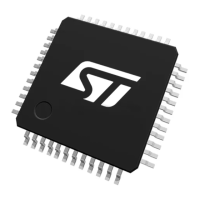Universal serial bus full-speed host/device interface (USB) RM0444
1278/1390 RM0444 Rev 5
The isochronous behavior for an endpoint is selected by setting the UTYPE bits at 10 in its
USB_CHEPnR register; since there is no handshake phase the only legal values for the
STATRX/STATTX bit pairs are 00 (DISABLED) and 11 (VALID), any other value produces
results not compliant to USB standard. Isochronous endpoints implement double-buffering
to ease application software development, using both ‘transmission’ and ‘reception’ packet
memory areas to manage buffer swapping on each successful transaction in order to have
always a complete buffer to be used by the application, while the USB peripheral fills the
other.
The memory buffer which is currently used by the USB peripheral is defined by the DTOG
bit related to the endpoint direction (DTOGRX for ‘reception’ isochronous endpoints,
DTOGTX for ‘transmission’ isochronous endpoints, both in the related USB_CHEPnR
register) according to Table 220.
As it happens with double-buffered bulk endpoints, the USB_CHEPnR registers used to
implement isochronous endpoints are forced to be used as unidirectional ones. In case it is
required to have isochronous endpoints enabled both for reception and transmission, two
USB_CHEPnR registers must be used.
The application software is responsible for the DTOG bit initialization according to the first
buffer to be used; this has to be done considering the special toggle-only property that these
two bits have. At the end of each transaction, the VTRX or VTTX bit of the addressed
endpoint USB_CHEPnR register is set, depending on the enabled direction. At the same
time, the affected DTOG bit in the USB_CHEPnR register is hardware toggled making buffer
swapping completely software independent. STAT bit pair is not affected by transaction
completion; since no flow control is possible for isochronous transfers due to the lack of
handshake phase, the endpoint remains always 11 (VALID). CRC errors or buffer-overrun
conditions occurring during isochronous OUT transfers are anyway considered as correct
transactions and they always trigger a VTRX event. However, CRC errors set the ERR bit in
the USB_ISTR register anyway, in order to notify the software of the possible data
corruption.
Table 220. Isochronous memory buffers usage
Endpoint
Type
DTOG bit
value
Packet buffer used by the
USB peripheral
Packet buffer used by the
application software
Transmit
(IN)
0
USB_CHEP_TXRXBD_0
(ADDRn_TX_0 / COUNTn_TX_0)
Buffer description table locations.
USB_CHEP_RXTXBD_0
(ADDRn_TX_1 / COUNTn_TX_1)
Buffer description table locations
1
USB_CHEP_RXTXBD_0
(ADDRn_TX_0 / COUNTn_TX_0)
Buffer description table locations
USB_CHEP_TXRXBD_0
(ADDRn_TX_0 / COUNTn_TX_0)
Buffer description table locations.
Receive
(OUT)
0
USB_CHEP_RXTXBD_0
(ADDRn_RX_0 / COUNTn_RX_0)
Buffer description table locations.
USB_CHEP_TXRXBD_0
(ADDRn_RX_0 / COUNTn_RX_0)
Buffer description table locations.
1
USB_CHEP_TXRXBD_0
(ADDRn_RX_0 / COUNTn_RX_0)
Buffer description table locations
USB_CHEP_RXTXBD_0
(ADDRn_RX_0 / COUNTn_RX_0)
Buffer description table locations.

